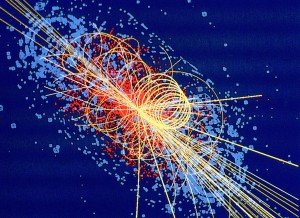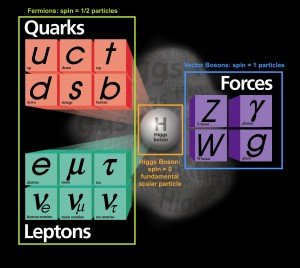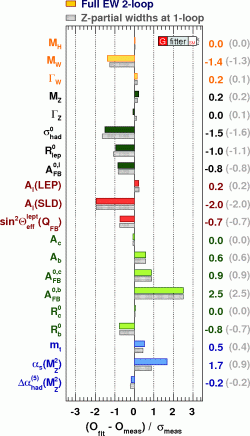Particle physics lectures - demystifying the Higgs boson (the theory context)
Who has never heard anything about the Higgs boson, this particle that has been discovered at the Large Hadron Collider (LHC) at CERN in July 2012 and whose related theoretical works have been awarded a Nobel Prize in 2013?
I introduce below details about Higgs physics, trying to answer most questions that a non-particle physicist may have about the famous boson. While this post mainly focuses on the theory side behind the Higgs boson, the next one will address the corresponding experimental aspects.


[ Image credits: Wikipedia and CERN ]
THE STANDARD MODEL OF PARTICLE PHYSICS
In the Standard Model of particle physics, the matter sector is made of twelve particles: six quarks (up, down, strange, charm, bottom, top), three charged leptons (electron, muon, tau) and the three associated neutrinos. Each particle has then a counterpart called an antiparticle with the same properties but an opposite electric charge.
 [image credits: Fermilab ]
[image credits: Fermilab ]
These elementary particles are interacting via the electromagnetic, the weak and the strong forces. In the quantum field theory framework, those interactions are mediated by force carriers, the so-called gauge bosons. There are several of them, namely the photon (electromagnetism), the W-boson and Z-boson (the weak interaction) and the gluons (the strong interaction).
An interaction between two elementary particles can then be seen as an exchange of a gauge boson, as illustrated in the figure below:

The ball stands for a boson and it is passed from one character to the other one. In this case, the boats will move away from each others. The interaction is said to be repulsive. Attractive interactions also exist (take two magnets for instance).
INTERACTIONS, SYMMETRIES AND THE PARTICLE MASSES
The three interactions of the Standard Model are based on symmetries called gauge symmetries. This assumption turns out to be powerful enough for deriving the properties of the force carriers and the way in which all elementary particles interact.
How can we be sure that those symmetries are the correct way to describe the microscopic world? We can never be sure, and a theory has to be tested. Data then tells us.
The Standard Model predictions have been tested in several thousands of different measurements during more than 40 years. There is up to now (almost) not a single sign of any deviation, and the gauge symmetries are suitable for explaining almost all particle physics data available today.
An example describing the Standard Model agreement with data can be found below, where the deviations between data and theory for several quantities are shown.
 [image credits: the GFitter collaboration ]
[image credits: the GFitter collaboration ]
The gauge symmetries however impose that all particles are massless, which is not seen experimentally. Gauge symmetries cannot be fully wrong, as we have an amazing agreement with data. But particles are massive so that one must modify the paradigm to introduce a way to embed the particle masses within the Standard Model.
This is where spontaneous symmetry breaking rescues us. This feature is enough to give all elementary particles a mass.
SPONTANEOUS SYMMETRY BREAKING IN A NUTSHELL
What does spontaneous symmetry breaking mean?
This is explained in these three scientific publications, one being written by Francois Englert and Robert Brout, one by Peter Higgs and a third one by Gerald Guralnik, Carl Richard Hagen and Tom Kibble. The three articles are all from 1964 and they are freely available on the Internet as pieces of history.
The spontaneous symmetry breaking mechanism applied in the context of particle physics is known as the Brout-Englert-Higgs mechanism. What about Gurlanik, Hagen and Kibble? Their article came later. That is part of the tough life of a researcher: being scooped...
Spontaneous symmetry breaking can be explained with a pen:
 [image credits: function space ]
[image credits: function space ]
On the left panel of the figure, the pen holds vertically (possibly because one holds it). As soon as the pen is left alone, it falls (on the right panel of the figure). The fact that the pen falls is exactly what breaks the symmetry.
To understand this last statement, we need to go back to the left picture.
There are many ways in which the pen may fall. The ensemble of all the possible ways forms the grey circle and has a revolution symmetry around the pen axis. No matter how we rotate the pen around itself, the ensemble of ways stays the same. This falling-pen problem actually features a rotation symmetry around the pen axis.
On the right panel of the figure, a specific way of falling has been adopted. The situation is not symmetric anymore. If we rotate the picture around the vertical axis (the before-fall pen axis), the fallen pen moves and we get a different figure.
A symmetry is said to be broken when the ensemble of solution (or ways in the above language) of a problem is symmetric, but one specific solution is not invariant under this symmetry.
THE RISE OF THE HIGGS BOSON
In the Standard Model, it is exactly the same situation. There are a full ensemble of viable solutions to its underlying equations, and this ensemble is gauge symmetric. Nature then chooses a specific solution to these equations and the gauge symmetries are hence spontaneously broken.
Several features consequently appear:
- All particles but the photons and the gluons get massive.
- There is a remnant of the symmetry breaking mechanism: a new particle called the Higgs boson.
- The strength of the interaction of a Higgs boson with a particle-antiparticle pair is proportional to the particle mass.
In order to validate the symmetry breaking mechanism as part of the Standard Model, once again we need to rely on data. Other options, like composite models or Higgsless theories, were considered as well before 2012.
Therefore, in order to validate the Brout-Englert-Higgs mechanism, it is necessary to first find the Higgs boson. But this is not enough. One needs also to measure its properties (in particular to validate the third item of the above list).
 [image credits: the particle zoo ]
[image credits: the particle zoo ]
@lemouth This is a great explanation, but isn't the higgs contribution to mass actually very,very tiny for items at rest? Doesn't it's contribution increase with the speed of the particle?
I'm only wondering because I watched this one and they seemed to be explaining it differently. In that interaction with the higgs field was proportional to speed.
Curious to know how inaccurate that is.
The video and my explanations agree. It however gives much more detail than I do.
I do not see where you observe any contradiction. Could you please be more specific?
The Higgs is the way to model the mass within the Standard Model. Taking the example of the electron, the strength of the interaction of the Higgs with the electron implies the value of the mass of the electron. There is no other contribution as the electron is elementary. You may be confused with composite objects like protons and neutrons whose mass is the sum of the masses of their constituents plus the binding energy which turns out to be the dominant contribution.
I didn't understand it that way. Could you please be more specific?
Yeah actually you're right I was just tired. I'm still in the stage of life where protons neutrons and electrons are all considered elementary. I still tend to forget these are not even the same class of particles.
Oh fyi, same company just realized a video explaining the 5th force. Literally just about word for word the same thing you said. You working with those guys or something?
Finally, I just did a blog posting ostensibly on the big bang. The reality is it's there to make people question if they believe a thing because of science or because it's commonly known. big bang is just a good example. I really do appreciate the efforts you guys are doing on the standard model though. Even if you straight up believed god himself set the big bang and the fundamental constants I wouldn't call that religion because you're doing the actual hard science of exploring and proving these things.
So I hope you don't take offense to the post. It's just there to make people question dearly held assumptions. Hopefully provoke them into thinking more critically. Also it does provide an alternative to the big bang, while providing a candidate for dark energy near as I can tell, so there's that. ;) Hope you enjoy it!
Maybe. Do you have a list of names somewhere?
Concerning the fifth force, I was visiting UC Irvine at the time they were writing their second paper. I had hence the chance to discuss a lot with the authors last May ^^
Concerning the big bang, it is fine. Don't worry. In any case, we are not capable to prove it at the moment, so as soon as other options are not being refuted in the light of present data and theoretical consistency, they are equally fine.
Awesome and no I have no idea who the writers are on that series. The host is a PhD who used to have his own web show. This series is produced by PBS which is the tax payer funded Public Broadcast System in the USA.
For some reasons I didn't check your posts before, but better late than never) Now follow you.
Very informative and fascinating. Thanks for sharing your research, keep it up.
Thanks! :)
So gauge symmetries say particles are massless, but particles have mass, and that mass comes from higgs bosons? Am I understanding correctly?
Also: "possibly because one holds it" lol
Let me give more details here.
Gauge symmetries implies that your basic Standard Model equation (the Lagrangian) is symmetric under the related symmetry transformation. It is turned into itself.
Now, once you consider the mass terms to be added to this Lagrangian to feature the particle masses, these terms turn out not to be invariant under the symmetry transformation. The only option is thus to forbid them. And we have the problem for the modelling of the masses in the Lagrangian. Particles are massive and not massless.
So how to introduce the masses?The idea is to add a new field, the Higgs field, that interacts (in a gauge symmetric way) with all the other particles. Once the gauge symmetries are broken, the interaction of the Higgs field with the elementary particles will imply that the particles will become massive.
Some of the degrees of freedom included in the Higgs field (3 out of the 4) will be absorbed by other particles to get their masses. One of these degrees of freedom is still there after the breaking of the electroweak symmetry. This is the Higgs boson that has been observed.
Is it clearer?
I will have to brush up on my particle physics but for now it's as clear as mud.
Well, the answer is more technical. You should start with the post above and maybe I could then help ^^
Yes, okay. Masses are not derived from the higgs boson, they are a function of particles interacting with the higgs field. The higgs boson is just one component of the higgs field.
I am still trying to give my self a simple way of understanding it in my head. This is interesting, but dense information for me :)
Difficult to say without entering deeply into the equations. I should not have used the world field... Well now it is too late... ;)
The Standard Model is a quantum field theory. Which means, you have strictly speaking only fields that interact with each other, and the field are the fundamental objects of the theory. The particles can be more seen as arising from the fields. And the Higgs boson arise from the Higgs field.
You may ask what is going on with the three other degrees of freedom of the Higgs field. A massless vector boson like the photon has two degrees of freedom, and a massive one like the W^+, W^- or Z bosons have three. We need to render three bosons massive... Then the count is right.
Very interesting.
Will follow for more!
well, it turns out that, http://www.sci-news.com/physics/science-techni-higgs-discovery-higgs-boson-02266.html i could explain why but i don't have any cred. i did though predict this when it was first "discovered"
These authors (I actually know two of them) are stating that there are other hypotheses as the one of the Higgs boson that would work as well. That's true. However, there are also hundreds of other hypotheses, and there is no way to experimentally disentangle any of those today (some of them being however very unlikely). That is what is called in the field the beyond the Standard Model field of research (which is my main field by the way).
All those theories are theories that are more fundamental than the Standard Model. However, once you take the limit of the energy regime probed so far, they all give the Standard Model as a result. That is why we cannot tell which one is likely and which one is not.
Now what we call the Higgs could be fundamentally something else, or could not be. What matters is that it behaves like a Higgs, acts like a Higgs, feels like a Higgs and smells like a Higgs. Whatever is the correct fundamental theory of nature, at the energy regimes we are probing today, it must encompass some object (elementary or not) that can be seen as a Standard Model Higgs boson.
My vote is the the higgs field is a settled matter. ;)
your best recommendation (book) for introduction to particle physics. please :)
It depends where you want to start. Are you looking more on the popular side or more on the formal side? For the former, I would recommend Veltman's book which is easy to follow and that I recommend to students who would like to have a first glimpse on the field. If you are more interested by equations, the Peskin and Schroeder is the bible.
I'll go gentler at first :) thank you!